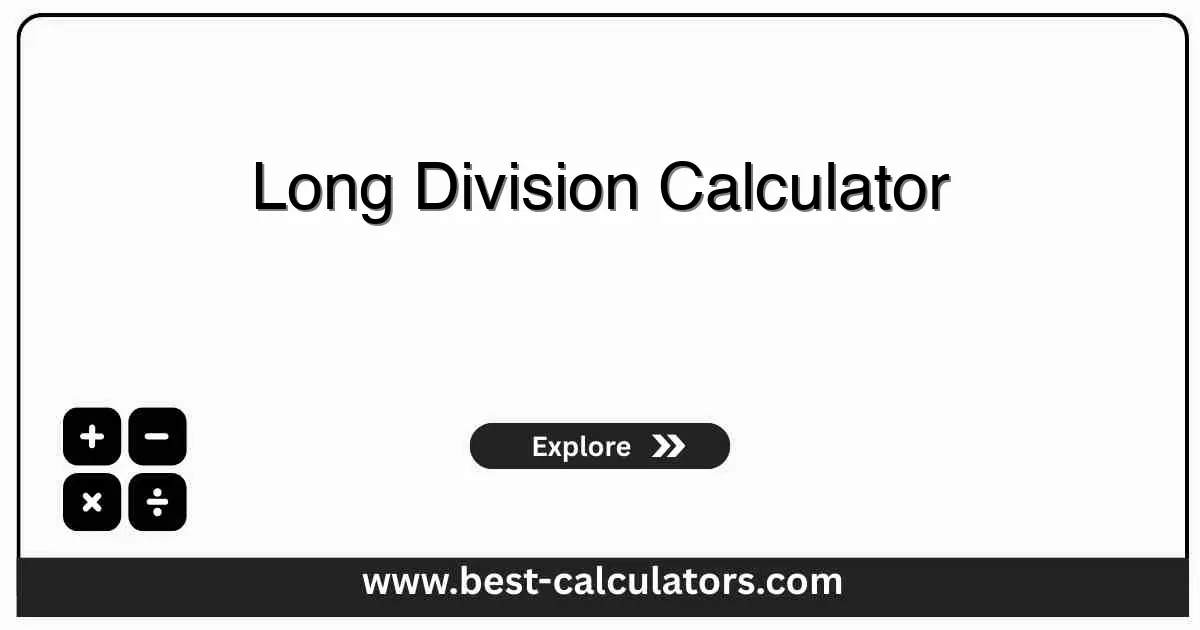Long Division Calculator - Divide Numbers with Steps Online
Perform long division with step-by-step solutions showing quotient, remainder, and complete division process
Long Division Calculator
Results
What is a Long Division Calculator?
A Long Division Calculator is a tool that performs division and shows the quotient, remainder, and step-by-step process for dividing numbers.
This calculator is perfect for:
- Students - Learning and practicing long division
- Teachers - Creating examples and checking work
- Parents - Helping with homework
- Quick Calculations - Fast division with verification
For basic arithmetic operations with a simple interface, try our Basic Calculator to perform addition, subtraction, multiplication, and division with instant results.
To find all factors of a number including factor pairs and prime detection, use our Factor Calculator to analyze number properties comprehensively.
For prime factorization with exponential form and division steps, check our Prime Factorization Calculator to break down numbers into prime factors.
To perform advanced scientific calculations including trigonometry, explore our Scientific Calculator for complex mathematical operations.
How Long Division Works
Long division follows this formula:
Components:
- Dividend = The number being divided
- Divisor = The number you're dividing by
- Quotient = The result (how many times divisor fits)
- Remainder = What's left over
Example:
Verification: 3 × 5 + 2 = 17 ✓
Key Division Concepts
Quotient
The main result of the division. It represents how many times the divisor fits completely into the dividend. In 17 ÷ 5, the quotient is 3.
Remainder
The amount left over. It must always be smaller than the divisor. In 17 ÷ 5, the remainder is 2. If the remainder is 0, the number divides evenly.
Decimal Division
Instead of stopping at a remainder, you can add a decimal point and zeros to continue dividing, getting a precise decimal result (e.g., 3.4 instead of 3 R 2).
Verification
The "Golden Rule" of division: (Quotient × Divisor) + Remainder = Dividend. This formula allows you to check any division problem instantly.
The Division Algorithm
Long division is based on a recursive algorithm that breaks a large problem into smaller, manageable steps.
The 4 Steps (DMSB):
- Divide: How many times does the divisor go into the current digit(s)?
- Multiply: Multiply that number by the divisor.
- Subtract: Subtract the result from the current digit(s).
- Bring Down: Bring down the next digit of the dividend.
This cycle repeats until there are no more digits to bring down. It is a perfect example of an algorithm—a set of precise instructions that guarantees a correct result.
History of Long Division
The method of long division we use today is relatively modern, but division itself is ancient.
Galley Method: In the Middle Ages, a method called the "Galley" or "Scratch" method was popular. It involved crossing out digits as they were used, often creating a shape resembling a ship's sail (hence "Galley").
Modern Notation: The familiar bracket notation ⟌ was introduced in the 18th century. It streamlined the process, keeping numbers aligned in columns (place value), which reduced errors significantly compared to earlier methods.
Why Learn Long Division?
In an age of calculators, why do schools still teach long division?
Number Sense: It forces you to estimate and understand the magnitude of numbers. You have to guess "how many times does 12 go into 156?" which builds intuition.
Polynomials: The steps for dividing numbers are exactly the same as dividing polynomials in algebra (e.g., (x² + 5x + 6) ÷ (x + 2)). Mastering arithmetic long division is the prerequisite for algebra.
Coding: Understanding remainders (modulo arithmetic) is crucial in computer science for tasks like cryptography, hash tables, and determining if a number is even or odd.
Real-World Applications
- • Resource Allocation: Distributing 1,000 items among 30 people evenly requires division to find the share per person and the remainder.
- • Unit Conversion: Converting minutes to hours (divide by 60) or inches to feet (divide by 12) often leaves a remainder (e.g., 130 mins = 2 hours, 10 mins).
- • Scheduling: Determining how many full cycles fit into a time period.
How to Use This Calculator
Enter Dividend
Input the number to be divided
Enter Divisor
Input the number to divide by
Calculate
Click to see quotient and remainder
Verify
Check the verification formula
Benefits of Using This Calculator
- • Instant Results: Get quotient and remainder immediately.
- • Automatic Verification: Shows proof that answer is correct.
- • Decimal Option: See result as both fraction and decimal.
- • Learning Tool: Helps students understand division concepts.
Factors That Affect Your Results
1. Divisor Size
Larger divisors produce smaller quotients and potentially larger remainders.
2. Division by Zero
Cannot divide by zero - this is undefined in mathematics.
3. Remainder Range
Remainder is always less than the divisor. If not, quotient can be increased.
4. Integer Division
This calculator works with whole numbers for quotient and remainder.

Frequently Asked Questions (FAQ)
Q: What is long division?
A: Long division is a method for dividing large numbers by breaking down the division process into a series of easier steps. It produces a quotient and remainder.
Q: How do I verify my long division answer?
A: Multiply the quotient by the divisor and add the remainder. The result should equal the dividend. Formula: (Quotient × Divisor) + Remainder = Dividend
Q: What is the difference between quotient and remainder?
A: The quotient is how many times the divisor goes into the dividend completely. The remainder is what's left over after division. For example, 17 ÷ 5 gives quotient 3 and remainder 2.
Q: Can this calculator show decimal results?
A: Yes, the calculator shows both the quotient with remainder (e.g., 17 ÷ 5 = 3 R 2) and the decimal result (3.4).